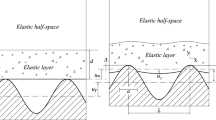Abstract
An elementary theory for a rigid spherical indenter contacting a thin, linear elastic coating that is bonded to a rigid substrate was developed. This theory predicts that contact area varies as the square root of the compressive load in contrast to Hertz theory where contact area varies as the two-thirds power of the compressive load. Finite element analysis confirmed an approximate square root dependence of contact area on compressive load when the coating thickness-to-indenter radius ratio is less than 0.1 and when the coating Poisson’s ratio is less than 0.45. Thin-coating contact mechanics theories that use either the Derjaguin-Muller-Toporov (DMT) approximation or the Johnson-Kendall-Roberts (JKR) approximation were also developed. In addition, a finite element simulation capability that includes adhesion was developed and verified. Illustrative finite element simulations that include adhesion were then performed for a thin elastic coating (rigid indenter/substrate). Results were compared with the thin-coating contact theories and the transition from DMT-like to JKR-like response was examined.
Similar content being viewed by others
References
C.-H. Hsueh, P. Miranda: Combined empirical-analytical method for determining contact radius and indenter displacement during Hertzian indentation of coating/substrate systems. J. Mater. Res. 19, 2774 (2004).
C.H. Hsueh, P. Miranda: Master curves for Hertzian indentation on coating/substrate systems. J. Mater. Res. 19, 94 (2004).
A. Perriot, E. Barthel: Elastic contact to a coated half-space: Effective elastic modulus and real penetration. J. Mater. Res. 19, 600 (2004).
F. Yang: Adhesive contact between a rigid axisymmetric indenter and an incompressible elastic thin film. J. Phys. D: Appl. Phys. 35, 2614 (2002).
T. Tang, C.Y. Hui: Decohesion of a rigid punch from an elastic layer: Transition from “flaw sensitive” to “flaw insensitive” regime. J. Polym. Sci., Part B: Polym. Phys. 43, 3628 (2005).
R.W. Carpick, E.E. Flater, K. Sridharan, D.F. Ogletree, M. Salmeron: Atomic-scale friction and its connection to fracture mechanics. JOM 56, 48 (2004).
K.L. Johnson, I. Sridhar: Adhesion between a spherical indenter and an elastic solid with a compliant elastic coating. J. Phys. D: Appl. Phys. 34, 683 (2001).
I. Sridhar, Z.W. Zheng, K.L. Johnson: A detailed analysis of adhesion mechanics between a compliant elastic coating and a spherical probe. J. Phys. D: Appl. Phys. 37, 2886 (2004).
M. Wang, K.M. Liechti, V. Srinivasan, J.M. White, P.J. Rossky, T.M. Stone: A hybrid molecular-continuum analysis of IFM experiments on a self-assembled monolayer. J. Appl. Mech.2004, (submitted).
F.W. delRio, M.P. de Boer, J.A. Knapp, E.D. Reedy Jr., P.J. Clews, M.L. Dunn: The role of van der Waals forces in adhesion of micromachined surfaces. Nat. Mater. 4, 629 (2005).
E.D. Reedy Jr., M.P. de Boer, A.D. Corwin, M.J. Starr, F. Bitsie, H. Sumali, J.M. Redmond, R.E. Jones, B.R. Antoun, G. Subhash, R.W. Carpick, E.E. Flater, M.D. Street, W.R. Ashurst: High Fidelity Frictional Models for MEMs. SAND2004-4791. (Sandia National Laboratories, Albuquerque, NM, 2004).
E.D. Reedy Jr., M.J. Starr, R.E. Jones, E.E. Flater, R.W. Carpick: Contact modeling of SAM-coated polysilicon asperities. (28th Annual Meeting of The Adhesion Society, Mobile, AL, February 13–16, 2005).
D.S. Grierson, E.E. Flater, R.W. Carpick: Accounting for the JKR-DMT transition in adhesion and friction measurements with atomic force microscopy. J. Adhes. Sci. Technol. 19, 291 (2005).
K.L. Johnson: Contact Mechanics. (Cambridge University Press, Cambridge, 1985).
B.V. Derjaguin, V.M. Muller, Y.P. Toporov: Effect of contact deformations on the adhesion of particles. J. Colloid Interface Sci. 53, 314 (1975).
K.L. Johnson, K. Kendall, A.D. Roberts: Surface energy and the contact of elastic solids. Proc. R. Soc. London A 324, 301 (1971).
J.R. Rice: A path independent integral and the approximate analysis of strain concentration by notches and cracks. J. Appl. Mech. 35, 379 (1968).
P.A. Klein: Tahoe User Guide. (Sandia National Laboratories, Albuquerque, NM, 2003).
J.R. Koteras, A.S. Gullerud: Presto User’s Guide Version 1.05. (SAND2003-1089, Sandia National Laboratories, Albuquerque, NM, 2003).
K.L. Johnson: Continuum-mechanics modeling of adhesion and friction. Langmuir 12, 4510 (1996).
D. Maugis: Adhesion of spheres: The JRK-DMT transition using a Dugdale model. J. Colloid Interface Sci. 150, 243 (1992).
Author information
Authors and Affiliations
Corresponding author
Rights and permissions
About this article
Cite this article
Reedy, E.D. Thin-coating contact mechanics with adhesion. Journal of Materials Research 21, 2660–2668 (2006). https://doi.org/10.1557/jmr.2006.0327
Received:
Accepted:
Published:
Issue Date:
DOI: https://doi.org/10.1557/jmr.2006.0327




